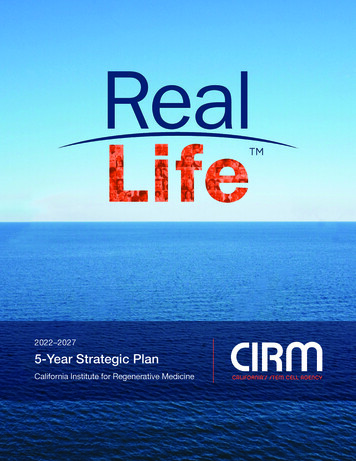
Transcription
2022–20275-Year Strategic PlanCalifornia Institute for Regenerative Medicine
TA B L E O F C O N T E N T SIntroduction. . . . . . . . . . . . . . . . . . . . . . . . . . . . . . . . . . . . . . . . . . . . . . . . . . . . . . . . . . . . . . . . . . . . . . . . . . . . . . . . 1Mission Statement. . . . . . . . . . . . . . . . . . . . . . . . . . . . . . . . . . . . . . . . . . . . . . . . . . . . . . . . . . . . . . . . . . . . . . . . . . 7Strategic ThemesTheme 1: Advance World Class Science. . . . . . . . . . . . . . . . . . . . . . . . . . . . . . . . . . . . . . . . . . . . . . . . . . . . 10Theme 2: Deliver Real World Solutions. . . . . . . . . . . . . . . . . . . . . . . . . . . . . . . . . . . . . . . . . . . . . . . . . . . . . 15Theme 3: Provide Opportunity For All . . . . . . . . . . . . . . . . . . . . . . . . . . . . . . . . . . . . . . . . . . . . . . . . . . . . . . 23Strategic Plan Summary. . . . . . . . . . . . . . . . . . . . . . . . . . . . . . . . . . . . . . . . . . . . . . . . . . . . . . . . . . . . . . . . . 29Organized For Operational Excellence. . . . . . . . . . . . . . . . . . . . . . . . . . . . . . . . . . . . . . . . . . . . . . . . . . . . . . . . . 30Strategic Planning Process. . . . . . . . . . . . . . . . . . . . . . . . . . . . . . . . . . . . . . . . . . . . . . . . . . . . . . . . . . . . . . . . . . 32Evie Padilla Vaccaro
IntroductionThe establishment of the California Institute for Regenerative Medicine(CIRM) under Proposition 71 in 2004 marked a historic moment for theadvancement of a new field in science and an investment in a new classof potentially curative regenerative medicine approaches.Since its launch, CIRM has been a leader in growingthe stem cell and regenerative medicine field whilekeeping the needs of patients at the core of itsmission by maintaining a partnership with the patientcommunity.CIRM has established a strong track record forstrategic investments in five pillars —infrastructure,education, discovery, translational and clinicalresearch. It has distinguished itself from other fundingagencies in the level of support and funding for theso-called translational research “valley of death,” thestage where scientific findings need further work tobe developed into potential therapies.CIRM 5 - Y E A R S T R AT E G I C P L A NCIRM funds novel “high risk but high reward”therapeutic approaches, and de-risks that investmentby selecting scientifically rigorous programs throughits highly refined peer review process, and byproviding guidance and expertise to the granteethroughout the project period.CIRM has built a vibrant regenerative medicineecosystem in California, funding the education andtraining of its future workforce, creating partnershipand investment opportunities through industryengagement, and addressing infrastructure gaps thathinder the progress of the field. 1
CIRM as the patient-centric funder: Advanced stem cell research and therapy development for more than76 Fundedclinicalwith 3,200 patients enrolled.75 diseases.trials, from first-in-human to pivotal phase 3, Engaged patient advocates at every step of the CIRM process from Board representation, toreview and approval of grant applications to collaborative advisory panels on clinical trial projects.40 children Helped cure overgene-modified cell therapies.of fatal immunological disorders withPatient-Centric FunderRonnie PriyankWhen Ronnie was born, he seemed like a happy,healthy baby. But within a few days, a newbornscreening test diagnosed him with X-linked SCID,a rare immune disorder that is often fatal within twoyears. Fortunately, doctors told his parents abouta CIRM-funded clinical trial conducted by UC SanFrancisco and St. Jude Children’s Hospital. Doctorstook some of Ronnie’s own blood stem cells and, inthe lab, corrected the genetic mutation that causedthe condition. They then gave him a mild dose ofchemotherapy, to clear space in his bone marrow,for the corrected cells to be placed and to grow.Over the next few months, the blood stemcells created a new blood supply and repairedRonnie’s immune system. He is now a happy,healthy three-year-old boy who loves goingto school with other children.This approach and others fundedby CIRM for various types of SCIDare currently being tested asinvestigational therapies in clinicaltrials to demonstrate both safetyand efficacy across a largepatient population.CIRM 5 - Y E A R S T R AT E G I C P L A N 2
CIRM as the seeder of innovative stem cell biologyand translational research:1,000 Supportedprojects at70 institutions across California.12world class stem cell research Fundedfacilities at California’s leading academic researchinstitutions.17 Overcame federal fundingrestrictions on hESC research by buildingshared research laboratories and by pioneeringthe derivation of new hESC lines.3,000peer-reviewed Facilitated overpublications of scientific and medical discoveries.2,600 Built the world’s largest iPSCresearch repository with overstem cell lines for modeling diseases suchas Alzheimer’s disease, neurodevelopmentaldisorders, and cardiomyopathies. Enabled innovative discovery and translationaltools such as cell and animal models, assays, andmanufacturing processes that have contributed tomore than 300 publications and 63 inventions. Spurred creation of novel genomic datasets andbioinformatics tools for stem cell research,including some of the earliest single-cell geneexpression atlases of the human body.CIRM 5 - Y E A R S T R AT E G I C P L A NInnovative ResearcherLili Yang, PhD, Associate Professor, UCLAFor the last eight years, CIRM has supported thework of Dr. Lili Yang’s laboratory in generatinginvariant Natural Killer T cells (iNKT) with five differentgrants spanning from the initial identification ofthe technology that produced the therapeutic totranslation stage development which culminatedin a formal pre-IND meeting with the FDA. Dr.Yang has used the iNKT platform to develop bothautologous and off-the-shelf allogeneic anti-cancertherapeutics designed to target blood cell cancers.Her work has been viewed as successful enough tobe the basis of a start-up company (Appia Bio) thatrecently announced a collaboration with KitePharma in order to help developand commercialize thispromising technology. Dr.Yang’s story capturesCIRM’s commitmentto supportinginnovative researchthat paves the wayfor developmentof next-generationtherapies. 3
CIRM as the accelerator fortherapy development1: Funded patient-centered clinical trials withthe highest standards of care by establishing5 Alpha Stem Cell Clinics thathave supported 100 clinical trialsacross the state.pioneering USclinical trials of hESCderived cell therapiesTherapy Acceleratorfor spinal cord injury, diabetes, and age-relatedmacular degeneration.Stanford University Supported the Enabled CIRM programs to qualify for15% of the regenerativemedicine advanced therapydesignation (RMAT) expedited pathwaydesignation issued by the FDA. Accelerated late-stage preclinical development73% of preclinicalprograms achieving FDApermission to initiate clinicaltrials within 2 years.withprogression of81 programs into therapydevelopment via successive CIRM Supported theawards, including 20 candidates that progressedfrom discovery or early preclinical developmentinto clinical trials.CIRM 5 - Y E A R S T R AT E G I C P L A NJoseph Wu, MD, PhD, Professor of Medicine,As the recipient of multiple CIRM awards, Dr. JosephWu has been extensively studying key safety aspectsof hESCs for many years. His work has producedhigh-impact publications and his observation thatpluripotent stem cells express novel immunogenicantigens shared by tumors has evolved into a cancervaccine technology that is now being developed byKhloris Biosciences, a biotechnology company spunout from Dr. Wu’s lab, in partnership with Leaps byBayer. Additionally, using his basic biology andpreclinical findings, in collaboration with City of Hopeand funded by CIRM, Dr. Wu developed a robust,GMP-compatible, scalable process to producehESC-derived cardiomyocytes for clinical use to treatischemic heart disease. In partnership with CIRM, Dr.Wu has launched the first-in-US clinical trial for thistherapy. His CIRM-funded work has also led to thedevelopment of hiPSC-derived cardiomyocytes withKhloris Biosciences as well as a collaboration with theUniversity of Goettingen’s Dr. Wolfram Zimmermannfor the potential clinical use of this technology as apatch. Dr. Wu’s story captures how CIRM researchersleverage CIRM support to translate basic biologicaldiscoveries into potentially transformative therapeuticcandidates for devastating diseases. 4
CIRM as the ecosystem builder:Trained over3,000students and scholarsto become the futureworkforce ofregenerative medicine.Stimulated the CA economy with 10.7B56,000of gross output andnew FTE jobs created duringthe 2004-2018 period.2PositionedCIRM-funded projectsto attract 18B of industry funding.Ecosystem BuilderSPARK ProgramTo train the next generation of stem cell scientists,CIRM created the SPARK (Summer Program toAccelerate Regenerative Medicine Knowledge)program to give high-school students from diversebackgrounds a chance to gain hands-on training instem cell research at some of the leading researchinstitutes in California. SPARK specifically selectsstudents who represent the diversity of California’spopulation, particularly those who might not otherwisehave opportunities to partake in research internshipsdue to socioeconomic constraints. To date, 482students have been trained by the SPARK program.CIRM 5 - Y E A R S T R AT E G I C P L A NSome trainees are still in high school but of 171 alumniwho reported college attendance: 40% attended /are attending a UC. 26% attending another CA school (Stanford,Caltech, CSU). 33% attend schools outside CA (Yale, Columbia,Harvard, Johns Hopkins, Duke, Princeton, etc.). Of 141 declared majors: 96% in biology andother STEM-related fields. 5
CIRM has come a long way but this is just the start of fully realizing the potential of what was made possible andset in motion by Proposition 71. In recent years, we have already seen examplesof how regenerative medicine approaches have the ability to transform the livesof patients. CIRM’s clinical trials using gene therapy to correct various forms ofinherited immune disease, success by others in gene therapy for spinal muscularatrophy and for inherited blindness, and the explosion of CAR-T therapies forrefractory and deadly cancers have marked the beginning of a new era.To realize the full potential of regenerative medicine for society, a significantamount of work is left to be done in basic and translational research and in thedownstream challenges of delivering these promising treatments to patients withdebilitating and fatal conditions. In addition, the continued success of the field willcreate more challenges —challenges in commercialization, equitable access totreatments, healthcare delivery models and payment models to support this newclass of therapies.The passage of Proposition 14 in 2020 has positioned CIRM to continue toaccelerate research, strengthen the ecosystem and drive innovative, real worldsolutions to deliver resulting transformative treatments to a diverse community ofpatients in need and to do so in an equitable manner.CIRM has expanded its mission statement to reflect the next phase of theAgency. CIRM will leverage its proven patient-centric funding and partnershipmodel to accelerate world class science into transformative regenerativemedicine treatments while committing to deliver these treatments in an equitablefashion to a diverse California and world. The strategy for accomplishing thisbold mission will leave a lasting legacy through the development of novelscientific endeavors, effective healthcare delivery models, and expandededucation and training programs.CIRM 5 - Y E A R S T R AT E G I C P L A N 6
MISSIONS TAT E M E N TAccelerating stem cell treatments topatients with unmet medical needs.Accelerating world class science to deliver transformativeregenerative medicine treatments in an equitable mannerto a diverse California and world.CIRM 5 - Y E A R S T R AT E G I C P L A N 7
Since its inception, CIRM’s mission and strategic goalshave stayed true to the spirit of Proposition 71 by strivingto rapidly advance stem cell and regenerative medicinetechnologies toward treatments and cures for patients’unmet medical needs.In 2006, CIRM’s first strategic plan and its missionstatement reflected the challenges and opportunitiesin the emerging field of stem cell and regenerativemedicine. The seminal paper on human inducedpluripotent stem cells had yet to be published. Secondgeneration CAR-T cell technology was showing promisein preclinical models but had not yet demonstratedits clinical potential. The 2006 mission statement thusfocused on the need to accelerate research of stemcell and regenerative medicine technologies whilemaintaining the highest medical and ethical standards.In 2016, as CIRM issued its final strategic planof the Proposition 71 era, the field had advancedconsiderably after several critical clinical milestones.CAR-T cells had demonstrated preliminary clinicalsafety and efficacy for blood cancers. Gene therapiesand gene-modified cell therapies had showed clinicalbenefit for rare monogenic diseases. Pluripotent stemcell-based cell therapies had progressed to clinicalstudies. CIRM’s mission statement was thus modifiedto capture the urgency of accelerating translationalresearch and propelling more promising therapies intoclinical development. The re-stated mission statementdefined the 2016 strategic plan’s goals of acceleratingtranslational research and developing the resources toultimately support 50 new clinical trials in 5 years.CIRM 5 - Y E A R S T R AT E G I C P L A NNow in 2021, as CIRM sets its vision for theProposition 14 era, its mission and strategic goalsmust reflect the current state of regenerative medicineand address the next decade’s challenges andopportunities. Today, the clinical benefit of stem cellsand regenerative medicine continues to be validated bythe hundreds of ongoing clinical trials and by the realworld use of approved therapies. New technologiessuch as CRISPR gene editing are showing clinicalpromise in genetic blood, eye and neurological diseasesas well as in cancer. Given the initial clinical successin rare blood diseases and oncology, stem cell andregenerative medicine technologies are being aimedat a broader range of diseases from rare monogenicdiseases to neurodegeneration, diabetes, and heartdisease. As the field advances rapidly, it is imperativethat the promise of regenerative medicine is realizedas accessible, transformative, real-life therapies forpatients across a diverse California and world. 8
With this mission as its “north star,” CIRM has set out anew strategic planthat seeks to address the challenges and opportunities presented bythe growing field of regenerative medicine.The strategy is organized into three major themes:AdvanceWorld Class ScienceDeliverReal World SolutionsProvideOpportunity for AllThe challenges, opportunities, and measurable 5-year goals related to each strategic theme are discussed below.CIRM 5 - Y E A R S T R AT E G I C P L A N 9
Theme 1Advance World Class ScienceAdvance World Class ScienceCIRM will leverage collective scientific knowledge to inspire collaborative research that addressesCalifornians’ unmet medical needs.5-year Strategic Goals: Develop next-generation technology competency hubsthat broadly empower and connect California’s researchecosystem Build knowledge networks that foster and advance noveldiscovery, translational and clinical research approachesThe field of regenerative medicine is advancing rapidly,driven by novel research tools and technologies thatgenerate terabytes of data on human biology, buthas to date resulted in few demonstrably effectivetreatments for devastating diseases. This is particularlytrue for diseases of the central nervous system wherethe complex biology underpinning neuropsychiatric,neurodevelopmental, and neurodegenerative diseasesis still coming into focus and disease-modifyingtherapies remain elusive. Several factors contributeto the limited scientific advancement in these areas,including: 1) Lack of attention and financial support(from non-profit and industry sectors) for high-risk/highreward research and therapy development, particularlyin disease indications that are not commercially viable(i.e., rare diseases) or are complex (i.e., CNS-relateddiseases), and 2) The siloed nature of biomedicalresearch and development. This strategic plan willaddress these key issues.High-Risk/High-Reward Research Projects. CIRM iscommitted to promoting the success of high-risk/highreward projects, including those targeting rare diseasesand neurological disorders. CIRM’s unique fundingpartnership model has provided predictable, reliable, andprogressive funding for projects that were considered toorisky in their discovery stages for financial support fromgovernmental institutions or industry 3.CIRM 5 - Y E A R S T R AT E G I C P L A NTo date: In addition to 76 CIRM-funded clinical trials, CIRMfunding of preclinical projects has enabled anadditional 31 non-CIRM funded clinical trials4. Nearly 12% of CIRM’s clinical funding compriseshigh-risk/high-reward stem cell and gene therapyapproaches for rare diseases. Almost a quarter of CIRM’s total funding has focusedon neurological disorders5 and 14% of its clinicalportfolio comprises CNS diseases. CIRM’s hiPSC repository has enabled studies inpsychiatric diseases: Broad Institute investigatorshave identified lines with extreme high and lowpolygenic risk scores for schizophrenia6.In this strategic plan, and in line with therecommendations of the Strategic Scientific AdvisoryPanel 7, CIRM will maintain and augment thiscommitment in two ways: 1) Continue the fundingmechanisms through the existing pillar programs; 2)Build infrastructure that organizes and democratizesdata through knowledge networks and acceleratesshared usage of specialized technologies throughcompetency hubs. This strategy will be deployedwithin the broad CIRM funding programs, but willinitially be designed to enable a consortium approachfor CNS research, including neuropsychiatric andneurodevelopmental disorders 8. 10
Theme 1Culture of Collaboration. CIRM is committed todeveloping a systematic approach that fosters “teamscience.” Scientific research and therapy developmenthas always been driven by small teams or targetedcollaborations between research labs. On the otherend of the spectrum, large-scale collaborative effortsdriven by public and private stakeholders tend to befewer in number but have demonstrated successstories; the advent of cancer immunotherapies or therecent rapid development of COVID-19 vaccines beingtwo of the more prominent examples. Despite theprevalence of small and large-scale collaborative efforts,the biomedical research enterprise still functions insilos where valuable data, resources and expertise areselectively shared.In recent years, there has been a paradigm shiftunderway in the culture of biomedical research towardone of greater data and resource sharingand broader coordination of research activities.While data sharing is not a new concept by anymeans, the current patchwork of public and privatedata repositories has several limitations including lackof data standardization, limited interoperability andlack of analytical toolkits. These limitations make itdifficult to access, combine and analyze the shareddatasets for meaningful research insights. To addressAdvance World Class Sciencethese limitations, the NIH and other institutions andorganizations have established data sharing policies andinfrastructure that adhere to FAIR data sharing principlesof findable, accessible, interoperable, and reusabledata for scientific research and therapy development9.CIRM will promote a culture of collaborative research byinvesting in the research and technology infrastructureto advance and facilitate sharing of unique resources(see section on competency hubs below) and meaningfulCIRM-funded research data (see section on knowledgenetworks below).Investments in technology competency hubs andknowledge networks will advance collaborativeworld class scientific research and fuel discoveriesthat could lead to translational and clinical candidates.This model will also support the potential for “reversetranslation,” where new knowledge gained fromlate-stage translational and clinical research couldbe addressed in discovery research which, in turn,could result in new translational and clinical programs.Importantly, both knowledge networks and competencyhubs will be integrated into CIRM’s funding pillars and inthe conduct of CIRM-funded research to ensure visibilityand broad use of these resources.Knowledge NetworkFoundational InsightsDiscoveriesTreatments and CuresShared CompetenciesCIRM 5 - Y E A R S T R AT E G I C P L A NBasic, Translational andClinical Research 11
Theme 1Advance World Class Science5-Year Strategic GoalsDevelop next-generation technology competency hubs that broadlyempower and connect California’s research ecosystemScientific progress relies on revolutionary andinterdisciplinary breakthroughs in technology. Cuttingedge methodologies such as CRISPR gene editing,human cell modeling of disease, machine learning,AI, and others could significantly enhance scientificdiscovery and accelerate therapy development.However, practical utilization of these innovationsoften requires upfront investment in technologies,iterative development and validation, standardization ofprotocols, and specialization in training and expertise.These barriers limit research access and can delaymaturation and widespread adoption of the technologyplatform. Individual academic institutions address thesebarriers with centralized core research facilities thathouse specialized equipment and provide accessibleexpertise and training broadly to the institution’sresearch labs and courses.10 Early in its history underProposition 71, CIRM established 17 shared researchlaboratories as core facilities for stem cell researchand training, many of which are still operational today.Proposition 14 re-establishes and expands the sharedlaboratories programs.CIRM will build on the shared laboratories modelto develop competency hubs that will acceleratehypothesis-driven research, translational and clinicaldevelopment of regenerative medicine therapies andworkforce development in CIRM’s pillar programs.The competency hubs will concentrate and networkdomain-specific expertise and innovation to develop,validate and broadly share unique technology-drivencompetencies. One example of competency hubsis an updated and expanded shared labs networkthat supports discovery research by providing broadaccess to diverse human cell models of disease11 and/or gene editing resources. Other forms of competencyhubs will be incorporated into existing or plannedCIRM strategic infrastructure such as Alpha Stem CellClinics, Community Care Centers, and the CaliforniaManufacturing Network (Explained further in Theme 2,Deliver Real World Solutions).CIRM 5 - Y E A R S T R AT E G I C P L A NThe competency hubs will offer expertise in noveltechnologies, trained personnel, training courses,equipment, and standardization of workflows to broadlyserve three functions: (1) innovate and improve on12 thetechnology core competencies to augment their impactfor CA researchers and to further support regenerativemedicine research and development; (2) provide broadaccess to the shared resources, training, and protocols;and (3) support and facilitate collaborative researchapproaches across CIRM’s discovery, translational andclinical pillars.“Updating the technologicalcapabilities of existing sharedlabs and stimulating partnershipswith institutions that currentlylack such expertise will create andstrengthen close collaborationsand generate a robust network oftherapy discovery and delivery.”—Lawrence Goldstein, PhD, ICOC Board MemberGiven the rapidly growing and evolving nature ofthe regenerative medicine field, a critical functionof each competency hub will be to continuouslyinnovate, develop and validate the core technologiesin collaboration with the users and other competencyhubs in the network. The competency hubs will provideinter-institutional access to the technology by sharingfacilities, training, equipment, materials, protocols,and/or expertise. For example, a disease modelingcompetency hub will provide access to facilities,equipment and training programs for deriving ordifferentiating cell lines and share the differentiated cells 12
Theme 1and appropriate protocols with researchers across thestate. The competency hubs will facilitate collaborativeresearch approaches by adapting their technology and/or developing specialized data and resource sharingmechanisms to facilitate the needs of the CIRM-fundedcollaborative projects. The competency hubs will alsoconstitute part of the CIRM collaborative ecosystemmaking all their data available through the CIRM datainfrastructure hub, also known as CIRM knowledgenetworks, which is explained further below.Advance World Class ScienceSome competency hubs will serve as a workforcetraining microcosm for local and neighboring institutions.Most California state universities and communitycolleges have neither the financial nor experientialbandwidth for innovative research, but they may harbor apotential diverse future workforce who could learn thesetechniques and utilize the technology platforms for smallscale research. CIRM’s network of competency hubs willexpand geographic access to diverse communities andprovide these institutions with a unique opportunity ofexposure to state-of-the-art platforms.Shared Stem Cell Laboratory at UCLASuccess Stories: First Generation Shared Research LaboratoriesUnder Proposition 71, a total of 17 Shared Research Laboratory grants were awarded to academic and nonprofit research institutes to provide dedicated laboratory space that was free of NIH support and equipped togrow and maintain hESCs, served as a shared resource with available core equipment and trained personnel,and in some cases, also provided specialized, hands-on training courses. Shared Labs were available notonly to stem cell scientists at the grantee institution but also to those from nearby institutions without suchfacilities. These dedicated, common laboratories encouraged optimal sharing among individual investigators,research groups and departments to foster a collaborative, multidisciplinary research environment, andpromote cost effectiveness. Many of these laboratories have sustained their activities beyond CIRM fundingthrough either fee-for-service contracts or other funding mechanisms and some have expanded theirservices. For instance, UCLA’s Shared Lab includes fully equipped GMP-GTP-compliant labs and USC’sspace contains core facilities for FACS, biological imaging, therapeutic screening, and tissue culture. In thisPlan, CIRM seeks to expand the Shared Lab model by creating networks of specialized and collaborativecompetency hubs that offer knowledge and best practices in innovative, next-generation technologies andcell and gene therapy development.CIRM 5 - Y E A R S T R AT E G I C P L A N 13
Theme 1Advance World Class Science5-Year Strategic GoalsBuild knowledge networks that foster and advance noveldiscovery, translational and clinical research approachesIn recent years, funding agencies, publishers,foundations, and academic institutions have adoptedmore robust data management and data sharingpolicies. Even with these attempts, there remains agreat deal of ambiguity around how and what to share,how to meet data sharing requirements and how toharmonize data across the diversity of public andprivate repositories, all of which significantly limit datausability, scientific productivity, and clinical relevance.“Making such data sharingand analysis across CIRMprojects operational and widelyaccessible would leverageCIRM investments, servingthe biomedical researchenterprise broadly.”– Keith Yamamoto, PhD, ICOC Board MemberCIRM will build knowledge networks that facilitatesharing of CIRM-funded data, leverage high-valueexternal datasets and build robust analyticaltools to maximize the real world impact of CIRMfunded research. To do this, CIRM will first foster aculture of open science. CIRM will clearly define itsown requirements and incentives for well-developeddata management and sharing plans in CIRM-fundedprojects and it will coordinate with other fundingagencies, publishers, and California academicinstitutions to harmonize, facilitate and reward effectivedata sharing practices. It will network on the one handCIRM 5 - Y E A R S T R AT E G I C P L A Nwith publishing groups to harmonize open sciencepolicies and incentivize consortium authorship models,and with funding agencies and institutions on theother hand to build professional reward systems forexcellent team science contributions. This multi-facetedapproach will generate a healthy culture in which teamscience is incentivized and the appropriate resourcesare deployed to achieve this goal13.The initial implementation of knowledge networks willfocus on accelerating collaborative CNS researchapproaches14 that will benefit the study of neurologica
Since its inception, CIRM’s mission and strategic goals . have stayed true to the spirit of Proposition 71 by striving . to rapidly advance stem cell and regenerative medicine technologies toward treatments and cures for patients’ unmet medical needs. In 2006, CIR
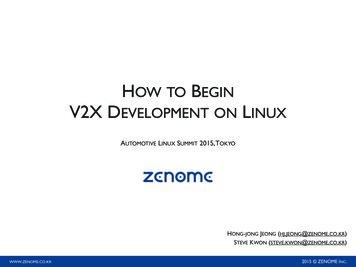
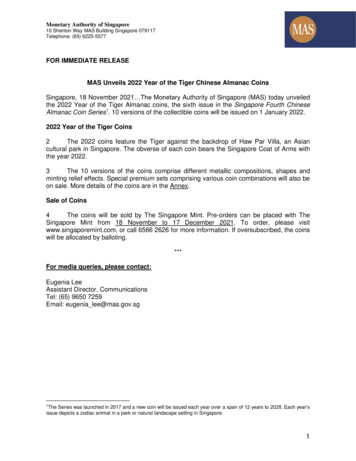



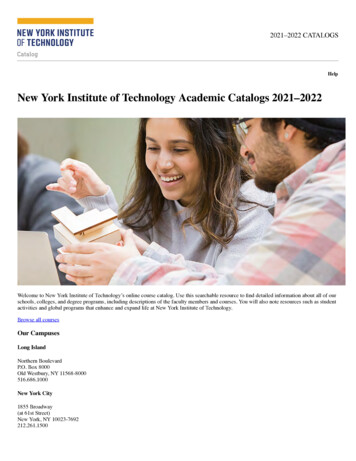
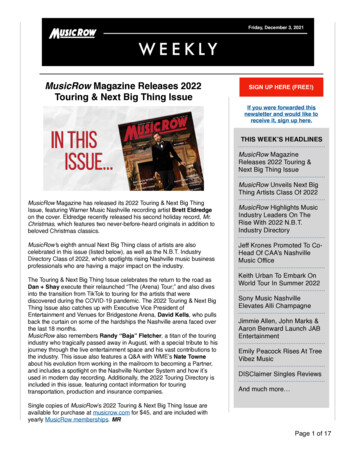
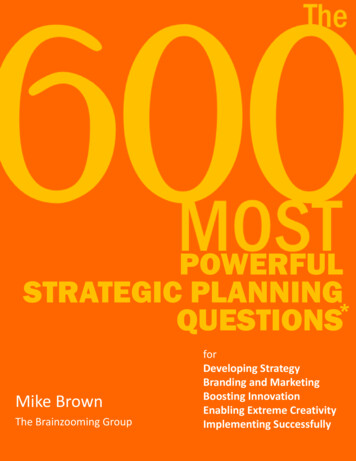
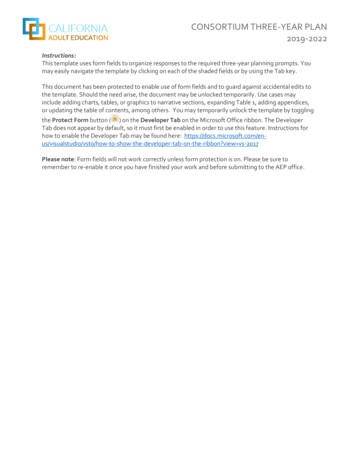
![Stamp Bulletin 376 [Jan-Feb 2022] PDF](/img/16/stamp-bulletin-375.jpg)
